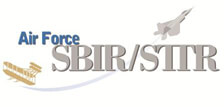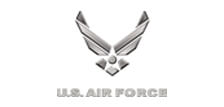Inlet Duct Robotic Drilling
Construction of the F-35 prototypes had hit a serious snag. Small-statured workers were having to don respirator, safety glasses, and gloves and squeeze into nine-foot long, twenty-inch-diameter inlet ducts to drill hundreds of holes with a template and hand drill. Not just once per plane but three times, to bore left, right, and aft ducts for the installation of fasteners to attach the ducts to underlying aircraft structure.
The predicament was due to a design change driven by the need to reduce aircraft weight.The original duct frame material was too heavy, so engineers substituted aluminum—but now the only way to attach duct to frame was to drill it from the inside out. Not only was the situation untenable from a worker safety standpoint, but in an ultra-high-performance aircraft like theJoint Strike Fighter, a hole is not just a hole. It’s a precise geometric component that demands hair’s breadth absolute positioning. That level of hand-drilled precision is a challenge in any circumstance, let alone in the confined, awkward space of an F-35 inlet duct. Production of the F-35 couldn’t ramp up until a solution was achieved.
Northrop Grumman, a principle member of the Joint Strike Fighter industry team,organized a consortium with the Society for Manufacturing Engineers to search for solutions. In 2006, Northrop reached out to the automotive industry, holding a seminar to present the problem and invite ideas. An engineer who was in the crowd took the challenge to Variation Reduction Solutions, Inc. (VRSI), a metrology and robotics company in Plymouth, Michigan, that he had worked with on a Harley-Davidson project. Ideas hatched, and in 2007 VRSI entered into a Phase I SBIR sponsored by the Joint Strike Fighter Program Office and managed by the Air Force Research Laboratory’s Manufacturing Technology (ManTech) office at Wright-Patterson Air Force Base in Ohio.
“I kept a little piece of paper on my desk so I would get it right—SBIR, not SIBR,”recalls Deborah Lowis, VRSI project manager. “I’d never heard of it before.”
After a successful Phase I, VRSI gathered a Phase II team that included Comau, Inc. to help with systems integration, Brown Aerospace to provide end effectors (a robot’s “hands”),PreCorp, Inc. for drill bits, and Northrop Grumman, the end user. Two Air Force F-35 engineers were also embedded with the team. In an astonishingly short time frame, the VRSI-led team ripped through an intense series of wildly successful Phase Is, IIs, and, IIIs, which produced technologies to robotically drill holes and manage and insert fasteners in F-35 production—technologies which are now also being used in the assembly of Boeing’s 777.
Forthe government’s investment of about $7.7 million in SBIR funds to support development of the inlet duct drilling and fastener management systems, the F-35 Joint Program Office estimates it will save more than $144 million over the manufacturing lifetime of the aircraft.
The first technology to be integrated into the F-35 production line—just three short years from the outset of the initial Phase I—was the Inlet Duct Robotic Drilling (IDRD) cell, which obviously enough robotically drills the inlet ducts. With the SBIR team’s skills and commitment and VRSI’s virtuosity with optical metrology and automation, robotic drilling reached new heights of accuracy in the effort.
“The team’s focus and expertise paid off,” says ManTech’s Deputy Division Chief ScottPearl, a key team member for the entire SBIR series. “Northrop Grumman implemented the robotic drilling cell in their F-35 Integrated Assembly Line in Palmdale, California, and they consider it the ‘Crown Jewel’ of their production line. The time to drill, countersink, and inspect close to 3,000 holes per aircraft has been reduced from 50 hours to 12.”
“It really is a game-changing technology,” agrees Lowis. “We were fortunate to be involved early in the process of trying to find a workable solution. We went into it knowing what the challenge was.” Lowis attributes the team’s achievements to an emphasis on communication and collaboration, and the shared sense of investment in making sure the technology worked as promised and was delivered on time to Northrop, with a strong return on investment to the government.
For any questions on the Video One Sheet, please email: info@mediamarketingconsultants.com
Back Home

